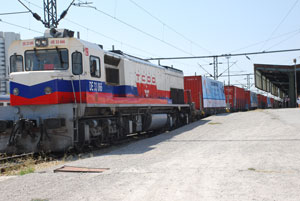The Minister of Mines and “Coordinator of Cluster for Economic & Infrastructure Development” said last month that the Railway Development Program of Afghanistan plans three lines totalling 2000 km and costing $5.938 billion [presumably US dollars].
- Shirkhan Bandar [for Tajikistan border] – Kunduz province – Balkh province – Herat [link to Iran]
Branch: Mazar-i-Sharif – Hayratan [Uzbekistan border]
Branch: Andkhoy – Aqina [Turkmenistan border]
- Mazar-i-Sharif – Pul-i-Khumri – Kabul – Jalalabad – Torkham [Pakistan border].
- Chaman [Pakistan] – Spin Boldak – Kandahar.
The statement says these lines would be 1435 mm (standard) gauge, designed for 25 ton axle loads, speeds of 100-160 km/h and capacity for 10-12 pairs of trains a day.
Building the northern corridor to standard gauge might make sense, however Hayratan – Mazar-i-Sharif is already being built to 1520 (Russian) gauge, and it is hard to see any possible justification for building Chaman – Kandahar to anything other than 1676 (Indian) gauge for compatibility with Pakistan.
Consultation Workshop on Railway Development Study
The “Consultation Workshop on Railway Development Study” took place at Kabul Serena Hotel. Topics of discussion included the development and acceleration the international trade, improvement of transportation networks in Afghanistan, providing competitive trade facilities and transit across Afghanistan, and the development plan of a railway that will join major trade centers of Afghanistan to neighboring countries.
His Excellency Wahidullah Shahrani, the Minister of Mines, and Coordinator of Cluster for Economic & Infrastructure Development, commented during his introduction, “Accelerating of the international trade requires the modernization of roadways and development of transport infrastructures, and, fortunately, the government of Islamic Republic of Afghanistan accepted the strategic goals of regional cooperation of Central Asia which is included the development of six transport routes in the region, and three of that will extend through Afghanistan.”
“Currently under construction is 75 Km of railway between Hairatan and Mazar-e-sharef, part of the first phase of the northern corridor railway plan. The second and largest stage of this project is generating an additional 1000 Km of railway”,said Mr. Shahrani.
Mr. Shahrani added, “The government of Afghanistan has a plan to generate a 2000 Km of railway, which could join the some of the country’s major cities to our neighboring countries.”
According to the Railway Development Program of Afghanistan, the first route begins from the port of Shirkhan and passes through the Kunduz and Balkh provinces, ending in Herat province. It will have two branches originating at Hairatan- Mazar, and, Andkhoi- Aqina. The second route will begin from Mazar, pass through Polikhomri, Kabul, Jalalabad, and end in Toorkham. and the third route in south of the country will begin at Spinboldak/Chaman and end in Kandahar city.
Commenting on some of the technical aspects of the railway, the Minister said, “The internal gauge of the lines is planned to be similar to 1435mm European railways, with a tonnage of 25 tons per axel and a speed of 100-160 Km per Hour. In the areas where a change of gauge is impossible, there will be special arrangements to replacement cargo. The primary capacity of the railway is 10-12 pairs of daily trains.”
The total cost of the project, including construction, engineering, environmental work, advisory services, and materials is estimated to be 5.938 billion dollars.
Attending the conference were some members of the Cabinet, members of the parliament, foreign ambassadors, representatives of European Union in Kabul, as well as some members of the private sector and international organizations.
Source: Ministry of Mines, 2010-05-23
